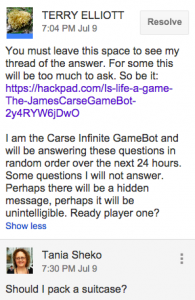It’s pretty obvious I haven’t been writing in this blog for so, so long and I guess it doesn’t matter because you go where you need to go, and I’ve been dipping into different communities and conversations online, mainly in groups on Facebook, Twitter and Google+. I’ve learned not to feel guilty when I can’t settle on one thing – hence the lack of focus for writing in this blog.
So #CLMOOC is happening, and I’m happy to get involved – because I feel the need to ‘do stuff’ that’s devised for me in the company of others, because the people I love doing stuff with are there (some of them), and because it’s time to get to know new people, and the best way to do that is to make stuff with them. For me, it’s much more satisfying than just people on Twitter with no unifying agenda (apart from learning, of course). Conversations happen, ideas and creative things are exchanged, and my network is widened again, including people I wouldn’t otherwise meet, people from all walks of life. Nice.
I’m about to look seriously at Make Cycle #2 because up until now I’ve been the rebellious child, refusing to sit still, not willing to follow the rules (not that there are any actually, just guidelines), coming in to join conversations here and there, admiring the creativity and ideas of others. Still sharing, but randomly, things I find inspirational – like the Gertrude Street Light Projection Festival which is magical.

Susan Watson put me onto the monsters in the PicsArt app (which I had been using in a limited way). I hid some amongst the birds in my rug. How many can you see?

I found an old high school sketch (and I mean OLD) and added a few.

All the while, saving things shared by people in Diigo and Pinterest.
What I love about CLMOOC is the philosophy and attitude of the group. For example, in the make cycle for week 2 you will read :
If you have just arrived … welcome. You are not late. You are right on time.
And also:
Finding ways to reciprocate generosity in our community is a key way for all of us to grow together even as we learn together.
This is a community I feel comfortable in, at home in, safe to play in.
And now, to get stuck into Make Cycle #2:
For Make Cycle 2, consider this idea of reaching out into conversation, of moving behind the “+1” or “like” or heart button into something deeper and richer, to be the very heartbeat of CLMOOC.
And this fantastic example of how powerful this idea can be:
In a recent blog post, Aaron Davis (whose blog ReadWriteRespond is a must-read) dives into the concept of his own writing life. Entitled “A Village Takes Many Things,” Aaron celebrated his own 300th blog post by reaching out to all of the people who have left comments at his blog site. He invited them through personal communication to write on the theme of the Village in a single blog post. And they did. Aaron’s project shows the ways in which connections ebb and flow, and he honored his readers as a reciprocal act of trust and connection.
I’m grateful that my options for this make cycle can be either to dip in, swim in or dive in. I’ve been dipping here and there, and know better than to permit the guilt monster to make me feel bad about not diving in if I don’t have the time or ideas. Reciprocating and connecting is something I think we learn to do over time, and keep learning. Reminding myself about the connected learning principles. I dwell on:
What would it mean to think of education as a responsibility of a distributed network of people and institutions, including schools, libraries, museums and online communities?
I fantasize about the school campus extending into other learning places – the museums, the art galleries, libraries, sustainable gardens, and the virtual spaces. (Hmm… but so much disruption to school routine). Virtual spaces are possible but how to go about this? In small ways, I think. Offering, modelling, enticing, leaping in when they’re ready to jump in.







































